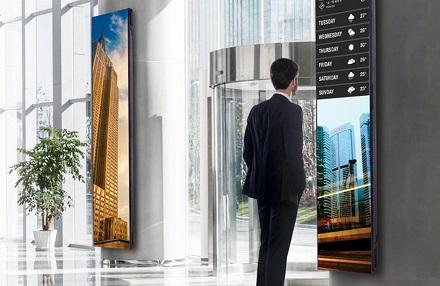

During the best of times, display technology — in the form of digital signage, video display kiosks and interactive wayfinding systems — is critical to informing and engaging people as they navigate public and private spaces. It can take on new importance now as stadiums and arenas across the country grapple with safety measures during the pandemic.
At a time when circumstances evolve quickly and up-to-date information is critical, digital signage, which can be changed at a moment’s notice, gives venue administrators the tools they need to keep consumers and staff informed.
As such, technology providers have started to develop a new category of turnkey digital health safety protocol solutions that combine video displays with software, sensors and more. But they are not necessarily one-trick ponies. At their core, these solutions include the kind of digital signage technology that supports visual communication in a variety of applications.
So, after helping sporting event organizers confront the challenges posed by the pandemic, these health safety protocol solutions can be redeployed for other ongoing communication initiatives, from mass security notifications to information about upcoming events.
Wellness Kiosks
For staff and fans entering a stadium, arena or field, many professionals will choose to screen individuals for possible infection. New all-in-one wellness kiosks are easy to set up at key entry points and don’t require staff to constantly monitor their operation. They include a vertically-oriented smart display with a built-in operating system for processing and presenting information, as well as an integrated thermal scanner for quickly and accurately taking people’s temperature.
Multipurpose wellness kiosks not only take temperature readings, they can show health safety video content or important messages about the venue’s protocols and plans. And many include built-in features such as motion-activated hand sanitizer dispensers and containers for offering masks or gloves. More advanced kiosks can automatically track hand sanitizer usage, so venues know not only that visitors are taking the important step of protecting themselves and others, but also when it’s time to refill the dispenser.
Occupancy Management Systems
Many venues’ health protocols will include limiting the number of people that enter a given space at the same time, such as a restroom. Occupancy management solutions for venues can help automate an important health protocol while also providing digital signage messaging.
Using sensors integrated with a smart digital display and a media player, venues can track and count fans and staff as they enter and exit a space. The system can display current occupancy levels versus venue-determined maximums and alert people about what they should do next. Such systems can usually be attached to a venue’s existing facility management systems so that staff automatically receive alerts on their phones and handheld devices when spaces are at full occupancy and arrangements should be made to accommodate waiting visitors.
Reconfigurable Digital Signage
Many sports arenas and stadiums already have digital signage displays mounted throughout their facilities for messaging, highlights, event schedules, food menus and more. Clearly, existing signage can be repurposed to communicate important health information as venues welcome back fans. But more visual communication may be needed – especially in locations not currently served by existing digital signage.
Mobile, reconfigurable health protocol signage solutions allow venues to position their messages in high-traffic locations and then move them as necessary. A built-in operating system and digital signage software allow staff to tailor messages from day-to-day and place digital signs at spaces that don’t currently include digital signage.
Various portable health protocol signage solutions, like some from LG, even come with batteries and high-brightness displays so they can be placed in outdoor field areas, for example, where people can read them in daylight and the venue doesn’t have to run power cords to them.
Safe Interactive Displays
Advanced technology has even made it so that interactive solutions, such as touch-enabled wayfinding displays, can be deployed safely by venues. As sports arenas navigate safe reopening during the pandemic, interactive touch technology can actually be “contact-less.” The touch functionality will still be there in the future, but for now interactivity can be accomplished by QR code scanners, voice control or gesture recognition integrated with new and existing systems.
For example, an attendee wants to find the nearest exit but doesn’t want to touch an interactive display. By scanning a QR code with her smartphone or making a certain gesture, an interactive map is replicated on her device or on the display and she can safely navigate routes and other information on the screen. Or she can speak to the interactive display and using artificial intelligence and voice recognition, the display can show her information the way today’s smart speakers do.
Ultimately, many of the features and functions of health protocol display solutions will have a useful life well beyond the current public health challenge. Venues that already have robust digital signage programs can easily see the value of added visual communication in reopening during the pandemic. And those just starting out can quickly adopt new health protocol solutions today and use them as the foundation of future digital signage applications.

